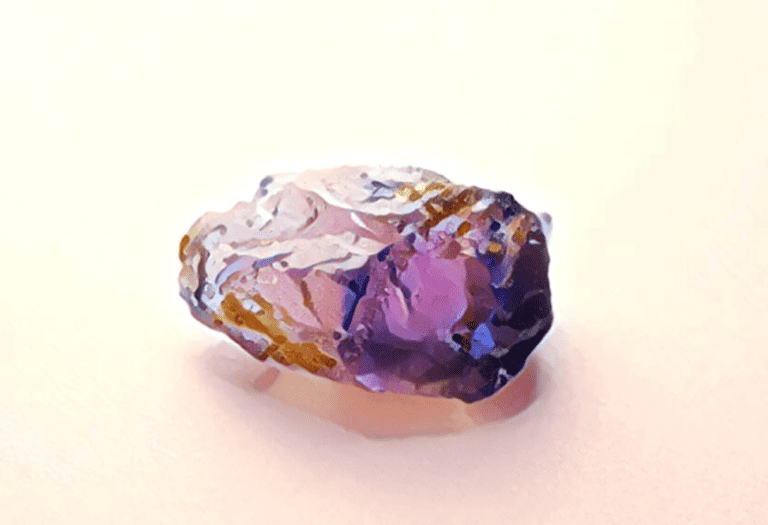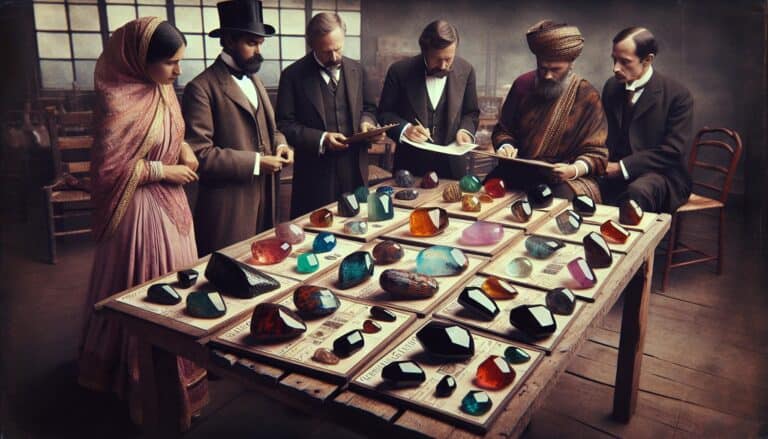Ever wondered about the value of that shimmering gemstone called andalusite?
It’s a unique gem that might not be in every jewelry store window but definitely deserves your attention. With its striking play of colors and pleochroism, andalusite boasts a beauty that can rival more well-known gems.
Determining the worth of andalusite isn’t as straightforward as you might think. It’s not just about size or color; there’s a myriad of factors that influence its market value. Whether you’re a collector, a jewelry enthusiast, or simply curious, understanding these factors is key to appreciating andalusite’s true value.
In the gemstone market, andalusite is a hidden treasure that’s gaining popularity. Its earthy tones and affordability make it an appealing choice for those looking to expand their collection without breaking the bank.
Let’s delve into what makes andalusite’s worth as captivating as its appearance.
Andalusite’s value is influenced by color, clarity, cut quality, and availability. Its pleochroism, showing different colors from various angles, makes color a key factor. High clarity and expert cuts increase value, while its rarity in the market, especially for natural stones, also affects its worth.
What Is Andalusite?
When you’re exploring the realm of gemstones, andalusite represents a fascinating specimen. It’s a lesser-known gem with a unique feature known as pleochroism. This remarkable characteristic allows andalusite to display different colors when viewed from various angles. Originating from areas such as Brazil, Spain, and Sri Lanka, this gem is truly a global treasure.
Andalusite is an aluminum silicate mineral, forming in metamorphic rocks under low pressure and high temperature. Its crystalline structure gives it a remarkable toughness, making it suitable for jewelry that withstands daily wear. This durability, coupled with its distinctive colors, captures the hearts of gem enthusiasts around the world.
While diving into the aesthetics of andalusite, you’ll encounter its signature earthy tones ranging from olive green to rusty red. What makes andalusite stand out is the strong pleochroic effect which often results in a mosaic-like appearance that’s both intriguing and delightful. This effect, combined with its clarity, contributes to the stone’s allure and value.
The market recognizes andalusite’s potential, particularly among collectors seeking something different from the usual selection. In terms of hardness, it’s rated at 7.5 on the Mohs scale, making it comparable to popular stones such as quartz. Yet, despite its impressive attributes, andalusite remains an affordable option for those looking to indulge in the charm of fine gemstones without breaking the bank.
Understanding andalusite’s composition and physical properties is key to appreciating its position in the gem market. Your knowledge of this gemstone’s uniqueness and practicality not only informs your purchasing decision but also allows you to recognize andalusite as a true hidden gem among a sea of well-known jewels.
Andalusite Prices: Factors That Affect Value

When you’re evaluating the worth of andalusite, several factors come into play that can significantly impact its price. From the quality of the gemstone to how many there are on the market, you need to consider a range of variables. Let’s break down these elements to help you understand andalusite pricing better.
Color, Clarity, and Cut Quality
The allure of andalusite is largely determined by its color, clarity, and how it’s been cut. These elements are interconnected, influencing each other and ultimately the gemstone’s overall aesthetic and value.
- Color: Andalusite stones exhibit pleochroism, which means the color you see varies depending on the angle. The most sought-after stones show clear and distinct color changes, with rich and vibrant shades. Typically, gems that exhibit a strong contrast between green, red, and yellow hues are more valuable.
- Clarity: Like most gemstones, the fewer the inclusions, the more valuable the stone. Andalusite gems with high clarity are rarer and therefore demand a higher price. However, some collectors value the presence of certain inclusions that can provide unique character and authenticate natural origins.
- Cut Quality: A well-executed cut can enhance the stone’s pleochroic properties, making color changes more pronounced and the stone more visually appealing. Skilled craftsmanship is required to bring out the gem’s best qualities, so premium-cut andalusite often carries a higher price tag.
Market Demand and Availability
Understanding supply and demand is crucial when calculating the value of andalusite. Since it’s not as well-known as other gemstones, the market for andalusite is less saturated, which can affect both its price and availability.
- Market Demand: As andalusite gains popularity, particularly among gemstone connoisseurs and jewelry designers looking for unique pieces, its demand could rise. Increased demand can lead to higher prices, especially for the highest quality specimens with exceptional color and clarity.
- Availability: Although andalusite is not the rarest gem on the market, its deposits are limited. Most andalusite comes from Brazil, Spain, and Sri Lanka, and the quantity mined each year is relatively small. Limited availability combined with increasing demand has the potential to push prices up over time.
Remember to factor in where you’re purchasing the andalusite from, as prices can vary significantly between different sellers and geographic locations. Local market trends, import taxes, and transportation costs can all influence the final price of the stone. Keep these aspects in mind to make informed decisions when investing in andalusite gems.
Understanding Andalusite: A Rare Gem

The Rarity of Andalusite
You’ve probably wondered why some gems are more valuable than others. Andalusite’s rarity is a significant factor behind its allure and worth. Unlike other common gemstones like quartz or amethyst, andalusite is far less abundant, making it a prized find for collectors and jewelers alike. This mineral is renowned for its unique pleochroic properties, which means it displays different colors when viewed from various angles. Andalusite’s scarcity is compounded by the fact that high-quality specimens suitable for cutting into fine gemstones are even rarer. Such pieces are often snapped up quickly by enthusiasts, which can drive up market prices, reflecting their coveted status.
Deposits of andalusite are primarily found in Brazil, Sri Lanka, and the Iberian Peninsula. Still, even within these locales, andalusite veins are sparse and sporadically distributed. Because it’s not found everywhere, your chances of encountering a piece at your local gem shop are slim, emphasizing its rarity and value.
Origins and Characteristics
The origins of andalusite give it a story as unique as its appearance. This gemstone is typically formed under the intense heat and pressure of metamorphic processes, which sculpt and transform it deep within the Earth. The conditions under which andalusite forms are very specific, and its presence can often tell geologists about the history and temperature of its host rock.
When assessing andalusite, it’s crucial to consider its defining characteristics:
- Color: Andalusite can range from yellowish-green to reddish-brown, with the most desirable color being a rich olive green.
- Transparency: This gemstone can be transparent to opaque. Transparent varieties are highly sought after for their superb clarity and are far more valuable.
- Cut: The skillful cutting of andalusite is vital to enhance the gem’s pleochroic effects. Masterfully cut stones that showcase vivid color changes are especially esteemed.
In addition to being a favorite among gem collectors and jewelry designers for its distinctive colors and pleochroic magic, andalusite’s durability also makes it suitable for everyday wear. With a hardness rating of 6.5 to 7.5 on the Mohs scale, it strikes a balance between toughness and beauty, assuring you can revel in its charm without undue concern for damage.
As you delve further into the world of gems and minerals, knowing origins and properties can be as rewarding as admiring their beauty. With its rare qualities and enchanting colors, andalusite stands out not just as a gemstone but as a marvel of natural processes that take place over millions of years.
Andalusite Grading and Valuation
The Grading System for Andalusite
When you’re looking to assess the value of andalusite, understanding the grading system is crucial. Just like diamonds, andalusite gemstones are evaluated based on several factors that determine their overall quality and worth. Color, clarity, cut, and carat weight are the primary criteria used in the grading process.
Color is perhaps the most significant aspect of andalusite’s appeal, with the gemstone’s unique pleochroism offering a play of colors – typically shades of yellow, green, and red. Collectors often seek out stones with the most dramatic color changes. Clarity follows, examining how free the stone is from inclusions or blemishes visible to the naked eye or under magnification. Cut influences a stone’s brilliance and also its pleochroic display. A skilled lapidary can enhance the stone’s best features and mask its flaws. Lastly, the carat weight affects the price, with larger stones being rarer and more valuable.
| Criteria | Importance |
|---|---|
| Color | Most significant factor |
| Clarity | Visibility of inclusions/belishes |
| Cut | Enhances brilliance and color |
| Carat Weight | Larger stones are more valuable |
You’ll often find that stones with a strong pleochroic effect and without significant inclusions fetch higher prices in the market.
Certification and Appraisal
In the realm of fine gemstones, certification is a vital step in establishing trust and value. A certified andalusite comes with a document provided by a reputable gemological laboratory, which attests to the gemstone’s authenticity and quality. During your search for andalusite, you might encounter certifications from organizations like the Gemological Institute of America (GIA) or the International Gemological Institute (IGI). These certifications can significantly influence the price of the stone, as they provide an official evaluation of the gemstone’s various quality attributes.
Appraisal is another key facet when determining andalusite’s worth. A professional appraiser provides an estimate of value, often needed for insurance purposes or resale. The appraiser will consider the grading report and current market trends to give you a valuation.
Insist on a detailed report that includes:
- A thorough description of the andalusite
- The grading results
- High-quality photos
- An estimation of the gemstone’s market value
Remember, while certification gives you a sense of security about the quality of your andalusite, appraisal gives you a current market value, essential if you’re considering selling the stone or holding it as a long-term investment.
Current Market Trends in Andalusite Pricing
As you delve into andalusite’s market scenario, it’s essential to understand that pricing isn’t static. Demand for unique gemstones like andalusite often fluctuates, impacting its price. Dealers and collectors alike prize andalusite for its distinctive pleochroism, but that’s just one facet influencing its value.
Traditional markets have seen a steady increase in andalusite prices due to its rarity and the growing interest among gem enthusiasts. Fine-quality specimens with exceptional color changes command higher prices, as they are more sought after by those looking to make a statement with their jewelry.
Online marketplaces have also revolutionized how andalusite is sold, offering a wide array of options for potential buyers. With the convenience of online shopping, customers now have access to global inventories, often finding better deals or rarer stones than are available locally.
Keeping an Eye on Supply Chains
Mining locations for andalusite are limited, with major deposits found in Brazil, Sri Lanka, and the United States. Since production can be constrained by geographical availability, any disruptions in these areas can lead to price jumps. For instance, sudden closures of mines due to unforeseen circumstances or political issues may tighten the supply, causing a spike in the andalusite market.
The Impact of Treatment and Synthetics
Another consideration for pricing is the treatment of the stone. Untreated and naturally splendid andalusite is valued more than stones that have undergone artificial enhancement. Moreover, the advent of synthetic andalusite has introduced a more affordable option for buyers, though it has also stirred concerns regarding the devaluation of genuine specimens. Always verify the origin and treatment history of an andalusite to assess its true value accurately.
Stay updated with gemstone trade publications and online resources to monitor the pulse of the andalusite market. Since andalusite isn’t as ubiquitous as diamonds or sapphires, even minor shifts in the gemstone market can result in significant changes in its worth. When considering an investment in andalusite or adding it to your collection, stay informed about the latest market movements for the most strategic acquisition.
The Most Expensive Andalusite
When searching for the pinnacle of andalusite gemstones, you’re likely to encounter specimens that are labeled as exceptionally valuable. The most expensive andalusite boasts a harmony of superior quality attributes that set them apart from average stones on the market. Color plays a pivotal role, with vibrant shades that demonstrate the stone’s unique pleochroism being highly sought after. Desirable colors include rich olive greens, warm reddish-browns, and striking gold tones, which appear to shift and change when the stone is viewed from different angles.
But color isn’t the only factor that contributes to the gemstone’s worth. Clarity is also crucial. Top-tier andalusite should be free from visible inclusions, which can detract from its beauty and perceived quality. Because andalusite naturally tends to have some inclusions, those rare specimens that are eye-clean command a premium.
Cut also significantly influences the value. A skilled cutter can enhance the pleochroic effects of andalusite, ensuring that the stone displays its best colors regardless of the viewing angle. Expert faceting can also maximize the stone’s brilliance, another aspect that impacts its price tag.
Finally, andalusite’s carat weight factors into its valuation, with larger, high-quality stones being more rare and thus more valuable. Despite this, andalusite typically doesn’t see the exponential price increases with size that some other gemstones do, as most high-quality pieces are often found in smaller sizes.
Here’s a quick overview of factors that may amplify the price of the most expensive andalusite stones:
- Intense pleochroic effect
- High clarity with minimal inclusions
- Precision cut to showcase color and brilliance
- Larger carat size without sacrificing quality
Prices for the finest andalusite can range significantly, but it’s not uncommon for superior gemstones to fetch several hundred dollars per carat. Keep in mind that prices are also influenced by market demand, the geographic origin of the stone, and its historical provenance if known. Always ensure that your high-investment andalusite comes with certification from a reputable lab, adding another layer of value and assurance to your purchase.
Buying Andalusite: Tips and Recommendations
When you’re looking to buy andalusite, knowing where and how to secure authentic and quality stones is essential. Navigate the market with confidence by arming yourself with the right knowledge.
Where to Purchase High-Quality Andalusite
Specialty Gemstone Retailers: Typically the best starting point for finding high-quality andalusite. These retailers often have direct relationships with mines and can provide detailed information about the origins and properties of their gems.
Online Marketplaces: A convenient option but requires caution. Look for sellers with:
- High ratings and positive reviews
- Detailed, clear photographs of the actual stones
- A transparent return policy
Gem Shows: These events can be a treasure trove for andalusite enthusiasts. You’ll find a range of qualities and prices, plus the added benefit of meeting experts and comparing offerings in person.
Independent Jewelers: They may offer custom pieces featuring andalusite. Ensure they have a good reputation for sourcing quality gemstones.
Ensuring Authenticity and Value
Certification: Always ask for a gemological certificate from a reputable lab—this is your proof of the gemstone’s authenticity and quality.
Factors Affecting Authenticity and Value:
- Origin: Certificates should state the geographic origin, which can greatly affect value.
- Treatment: The certificate should disclose any treatments the stone has undergone.
Appraisal: For added peace of mind, consider an independent appraisal. A professional appraiser will examine the andalusite and provide an objective assessment of its market worth.
Purchase Documentation: Keep all records of your purchase, including:
- Detailed receipts
- Certificates of authenticity
- Appraisal reports
These documents are crucial, especially if you ever decide to sell the gemstone or require it to be insured. Remember, your due diligence when buying andalusite ensures you get the true value for your money.
Conclusion: Buying & Selling Andalusite
You now understand that the true worth of andalusite isn’t just in its price per carat but also in its authenticity and history.
By choosing reputable sellers and ensuring your purchase comes with a gemological certificate, you’re investing in peace of mind. Remember to seek an independent appraisal and keep your documentation safe. This way, you’re not just buying a gemstone; you’re making a wise investment that stands the test of time.
Whether for personal enjoyment or as part of a collection, your andalusite is a treasure with a value that goes beyond the ordinary.


![Florida Rockhounding Sites in [year]: Basalt to Coral](https://observationhobbies.com/wp-content/uploads/2024/01/4hqOrGZcaIuK7n2K2N9d0-768x439.jpg)



![Vermont Rockhounding Sites in [year]: Locations & Gems](https://observationhobbies.com/wp-content/uploads/2024/01/rDTv0xwgU07GnklNt-0ym-768x439.jpg)
